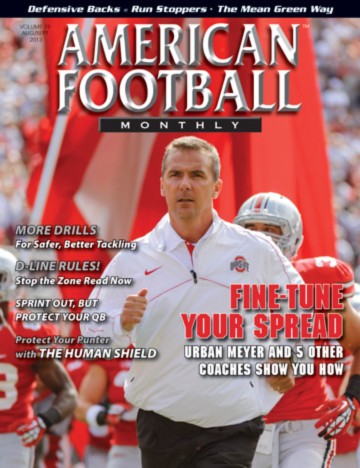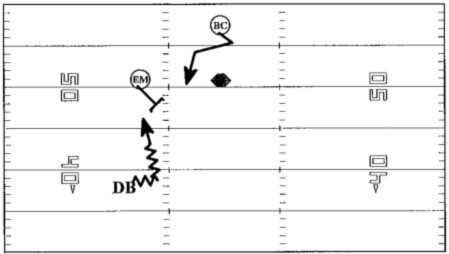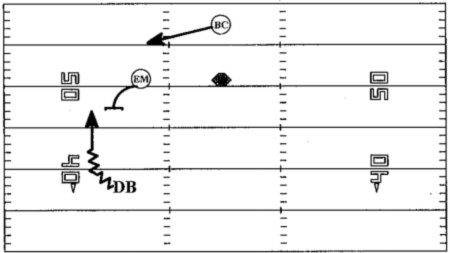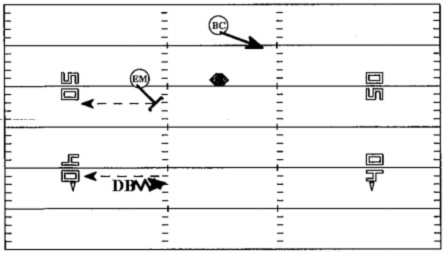Article CategoriesAFM Magazine
|
D-Back Run Stoppers Both the Key Read Drill and Block Escape Circuit Drill will improve defensive backs’ recognition of the run.by: Ernest MooreDefensive Coordinator • University of Chicago © More from this issue Stopping the run is one of the main priorities of any defense. In order to accomplish this goal, the defensive secondary must be active against running plays. It is important that all members of the secondary are equipped with the skills to recognize the run and then be able to execute techniques to disengage blocks. Your secondary can sharpen their eye discipline, footwork and hand placement/combat skills by recognizing the intentions of the End Man on the Line of Scrimmage (EMOL) and being prepared to escape block attempts through drill work several times a week. The drills that have provided the most value for our DBs are the Key Read Drill and Block Escape Circuit Drills. This series of drills present the players with basic reads that call for simple responses. The simplicity of the drills will create confidence in the defenders’ reads and reactions. To create eye discipline and proper footwork with vision on your keys, use the Key Read Drill. This drill works well for both corners and safeties in their zone coverage responsibilities. The coach will need three participants in order to start the Key Reads Drill – a defender, an EMOL, and a ball carrier. The coach will control the action three to five yards behind the defender. From this position, give the EMOL and BC a direction for the defender to key. Initially, the EMOL’s block directions are simple down, reach and base blocks. The BC will run inside/outside zone and power “tracks” from the backfield for the defender to get his secondary key. The coach should make sure to give the EMOL and BC directions that will create a familiar run scheme for the defenders. The defender should react to each run look according to the scheme of the defense and its coverage. Typically, the DBs will start recognizing run schemes to break bad habits of bailing, as most DBs are naturally conditioned to backpedal on the snap. When members of the secondary are tied to the box as force defenders, it is customary for the DBs to mirror the initial step of the EMOL. Their mirror step should only be about a six-inch step to a full step to assure that leverage is maintained. As the EMOL moves, the DBs must keep leverage with him by shimmy stepping with him step for step. Shimmy steps are shorter strides at a controlled pace. We use shimmy steps because it allows our players to read the entire picture under control of their body while still being aggressive in their reads. This is a critical movement for our players. As they recognize the “Initial Key”, it is important to emphasize that if the EMOL is a TE, the DB must see him engage before looking for his secondary “Pursuit” key in the backfield. Any retreat or kick-slide from the EMOL usually means the DBs should expect to see pass and will begin their drop into pass coverage. They should keep their eyes alert and, if they are a box defender, clear the draw with a three-step technique. Our DBs expect to get a true read on the run/pass key from the movement and noise of the line action (EMOL). Noise is considered the sound of the collision being made at the point of attack. More times than not, if the noise seems light, the offense is looking to pass the ball. Any communication from other defenders to secure this read properly is considered, but there is no better confirmation of your “Initial Key” than the sight itself. The pursuit key is the second read of the backfield action. Many teams are primarily one running back offenses, and this helps clear the picture for the secondary. The pursuit key dictates the urgency and angle the secondary will enter the box on the handoff. Any time the initial key and pursuit key work toward one side, the defenders should be ready to attack their gap or alley with vision on the BC. With both the initial and pursuit key working away from the DB’s side, the defenders are relaxed and prepared for any cutbacks or bootlegs. It can be difficult at first for your DBs to keep vision on the entire action, but over time their eyes will be able to focus on the initial key as they read the intentions of the pursuit key. But, once the DBs have a good understanding of gap and zone schemes they may see, they then progress to play-action and drop back key reads (Diagrams 1-3). During the week of a game, prepare your players based off the running and play-action schemes they will encounter on game day.
Diagram 1: Gap Scheme - Power Look
Diagram 2: Zone Scheme - Outside Zone Look
Diagram 3: Play-Action Scheme - Run Away Followed by Naked/Boot The next progression after recognizing the run is evading or disengaging all block attempts. The Block Escape Circuit is a good drill to get multiple repetitions of different techniques in a short amount of time. The drill starts by pairing your DBs head-up and then choosing a side to be your defenders. During the circuit, each DB will practice the following techniques – counter and quick swim, counter and rip, push pull and chop dip. In the counter series, the key coaching points are similar to pass rushing hand combat techniques. The DB is asked to get skinny by taking a half-man step to the side he plans to evade the block from while keying the hands of the blocker. The DB should create less of a blocking surface by slightly turning his hips and shoulders into the move. When the blocker throws his hands to attempt a block, the defender should aim his counterpunch at the blocker’s near wrist or elbow. For the defender’s counter punch, he should practice using the same hand as the foot he took the half man step with. Once the defender has control of the blocker’s wrist/elbow, he should look to clear the blocker with a quick swim stroke just over the arms of the blocker as he clears his off leg as well. In order to complete the block escape, the defender must clear the hips and replace the heels of the blocker. The DB should now be back to back with the blocker. The DB should circle around the blocker to reload the drill. The counter and rip has the same techniques except he will finish with a violent rip through the blocker’s arms. The combination of the half-man steps and replacing the heels have forced WRs to move their feet and be more active when blocking. For the defense, this has led to quite a few holding penalties on wide receivers. If the defender has good accuracy with his counter and quick swim/rip punches, he should secure a clean block escape. The DB can also look to grab the near shoulder and pull the blocker forward before quick swimming or ripping, if the blocker is smaller or weaker than the defender. The Push Pull Drill has helped our DBs escape blocks when being engaged by a blocker. The technique of this drill normally starts with the DB being engaged, with his hands located on the inside breast plate of the shoulder pads grabbing cloth. The defender’s eyes should be under the chin strap of the blocker, with his hips pressed down. Once they are in a good football position, they are ready to begin. Have the DB violently come out of his hips and press the blocker backward. We are looking for the WR to be placed on his heels so that the DB can sharply change his direction by violently pulling the blocker forward. Our goal is to force the blocker’s eyes and momentum to move to the ground in a direction that is down and away from the area he will look to escape. The DBs will finish the escape by releasing the blocker’s hold with a rip and will then clear the hips and replace the heels of the blocker. The final technique is the Chop Dip move. The Chop Dip move is a pass rushing technique that DBs have adopted when attacking a potential blocker from either side at an angle. The defender will start with a 45-degree angle and attack the blocker as he approaches. The Chop Dip is very similar to the counter series, as the DB looks to use the offensive player’s aggression against the defense. Once the blocker presents his hand, the DB will violently use his inside hand to chop downward on the hands of the block attempt. This motion will force the DB to get low and sink his hips, centering his gravity. The DB now must use this leverage to lean against any resistance from the blocker and work around him to clear the hips and replace the heels of the blocker. Adding counters to the Chop Dip move can be helpful as the DBs become familiar with the technique. The key is to be quick with hand placement of the chop and dipping with good leverage to get around the block. You can utilize this technique when blitzing DBs as well. The combination of the Key Read Drill and the Circuit Drill has helped improve defensive backs recognition of the run and then have them able to support the other “Box” defenders. The Key Read Drill has been invaluable for younger DBs in helping them understand running schemes and how to attack them. The Circuit has become a way to equip DBs with multiple moves that they can creatively use throughout the course of a game. Coach Moore answers your questions on Facebook - just go to https://www.facebook.com/AmericanFootballMonthly/ Quarters vs. The Run Game: Adding the Safeties – June, 2013 |
|
| HOME |
MAGAZINE |
SUBSCRIBE | ONLINE COLUMNISTS | COACHING VIDEOS |
Copyright 2024, AmericanFootballMonthly.com
All Rights Reserved







